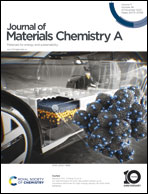A novel solid-state synthesis route for high voltage Na3V2(PO4)2F3−2yO2y cathode materials for Na-ion batteries†
Abstract
Polyanionic compounds, particularly Na3V2(PO4)2F3−2yO2y (NVPF3−2yO2y, 0 ≤ y ≤ 1), have emerged as promising cathode materials for Na-ion batteries since they demonstrate electrochemical performances comparable or even superior to most layered transition metal oxides. However, numerous discrepancies are reported in the literature regarding the solid-state synthesis of NVPF3−2yO2y compounds (especially Na3V2(PO4)2F2O and Na3V2(PO4)2FO2). Herein, we report the successful solid-state synthesis of phase pure NVPF3−2yO2y (y = 0, 0.5, 1) compounds from a new reaction pathway using the pyrophosphate (VO)2P2O7 as a precursor. We demonstrate that the novel reaction route offers a more direct pathway to phase pure compounds by combining in situ X-ray diffraction (XRD) during calcination and theoretical calculations (Density Functional Theory). The latter shows that the new pyrophosphate route is thermodynamically favourable as compared to the previously reported ones involving VOPO4. High temperature in situ X-ray diffraction (XRD) was used to observe the structural evolution during synthesis of NVPF3−2yO2y compounds from either VOPO4 or (VO)2P2O7 sources, clearly showing a direct pathway to the final products, with crystallization starting at temperatures as low as 350–450 °C. The desired quality of the products has been verified by XRD, combined with X-ray absorption and X-ray photoelectron spectroscopy, which confirmed the expected V oxidation state. Finally, we have verified the excellent energy storage performances of the NVPF3−2yO2y compounds in Na half cells with realistic areal mass loading of the electrodes and despite the absence of conducting coating on the surface. The intermediate material with y = 0.5 appears particularly promising both in terms of rate capability and capacity retention, thanks to the fully single-phase reaction mechanism during charge/discharge. Our work expands the range of available synthesis reaction routes for NVPF3−2yO2y materials, offering the possibility to better control the oxidation state of V, the stoichiometry in terms of O/F content and the crystal structure, and ultimately the resulting electrochemical performance.



 Please wait while we load your content...
Please wait while we load your content...